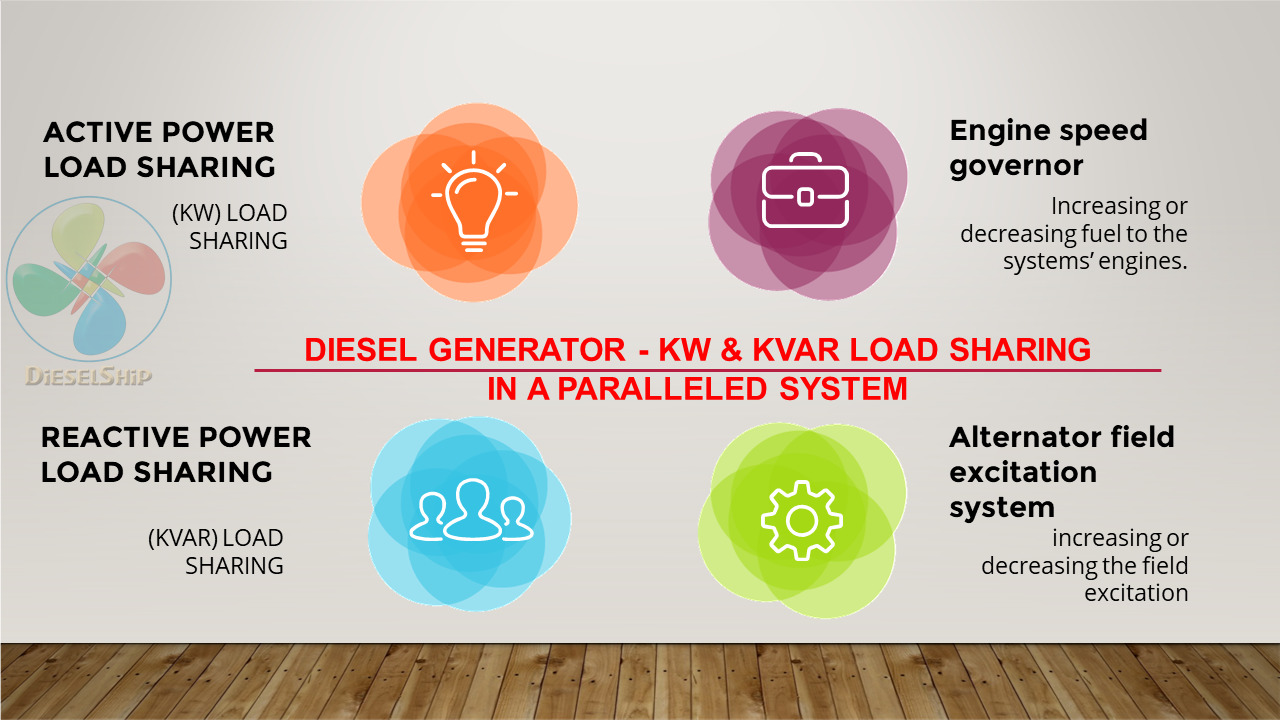ACTIVE & REACTIVE POWER SHARING IN PARALLELED GENERATORS (KW & KVAR)

ACTIVE & REACTIVE POWER SHARING IN PARALLELED GENERATORS (KW & KVAR)
LOAD SHARING
- Load sharing is defined as the proportional division of the kW and kVAR total load between multiple generator sets in a paralleled system.
- Load sharing is essential to avoid overloading and stability problems on the systems’ generator sets.
ACTIVE POWER (KW) LOAD SHARING
- When generator sets operate in parallel, the engine speed governor of each generator set determines the proportional sharing of the total active power requirements (kW) of the system.
- The kW load sharing is achieved by increasing or decreasing fuel to the systems’ engines.
- As the fuel to the engine of one generator set in a group is increased it will not lead to an increase in speed and hence frequency (as it would if it were operating alone) but it will lead to an increase in the proportion of the total kW load that it will deliver. Meaning, By increasing fuel to one generator engine among others connected in parallel, it would simply reduce fuel supply to the engines to compensate. But, if the engine is running alone, then increasing fuel shall increase the frequency (considering other safeties not incorporated)
- Likewise, As the fuel to the engine of one generator set in a group is decreased it will not lead to a decrease in speed and hence frequency (as it would if it were operating alone) but it will lead to a decrease in the proportion of the total kW load that it will deliver.
- The control system of the generator sets (via the engine speed control system) monitors and controls the sharing of the total kW load in proportion to the relative rating of the engines on the systems’ generator sets.
REACTIVE POWER (KVAR) LOAD SHARING
- When generator sets operate in parallel the alternator field excitation system of each generator set controls the proportional sharing of the total reactive power requirements (kVAR) of the system.
- The kVAR load sharing is achieved by increasing or decreasing the field excitation to the systems’ alternators.
- As the field excitation of one generator set in a group is increased i.e. overexcited it will not lead to an increase in voltage (as it would if it were operating alone) but it will lead to an increase in the proportion of the total kVAR load it will deliver and a decrease in its power factor.
- As the field excitation of one generator set in a group is decreased i.e. under-excited it will not lead to a decrease in voltage (as it would if it were operating alone) but it will lead to a decrease in the proportion of the total kVAR it will deliver an increase in its power factor.
An undesirable circulating reactive current (cross current) will flow in the system if the excitation of the alternators is not matched.
- The voltage control system of the generator sets (via the alternator voltage control system) monitors and controls the sharing of the total kVAR load in proportion to the relative rating of the alternators on the systems’ generator sets.

Excellent explanation.
I have not seen so far.
Pls explain different rating alternator load sharing
Really an excellent explanation in minimum words
We can view active load sharing in KW meters of each generators in parallel. How we can find the reactive power (kVAR) weather it is sharing or not.
I want to ask
Is “ACTIVE & REACTIVE POWER SHARING IN PARALLELED GENERATORS (KW & KVAR)” will have same principle if we use PARALLELED ALTERNATOR? Not generator